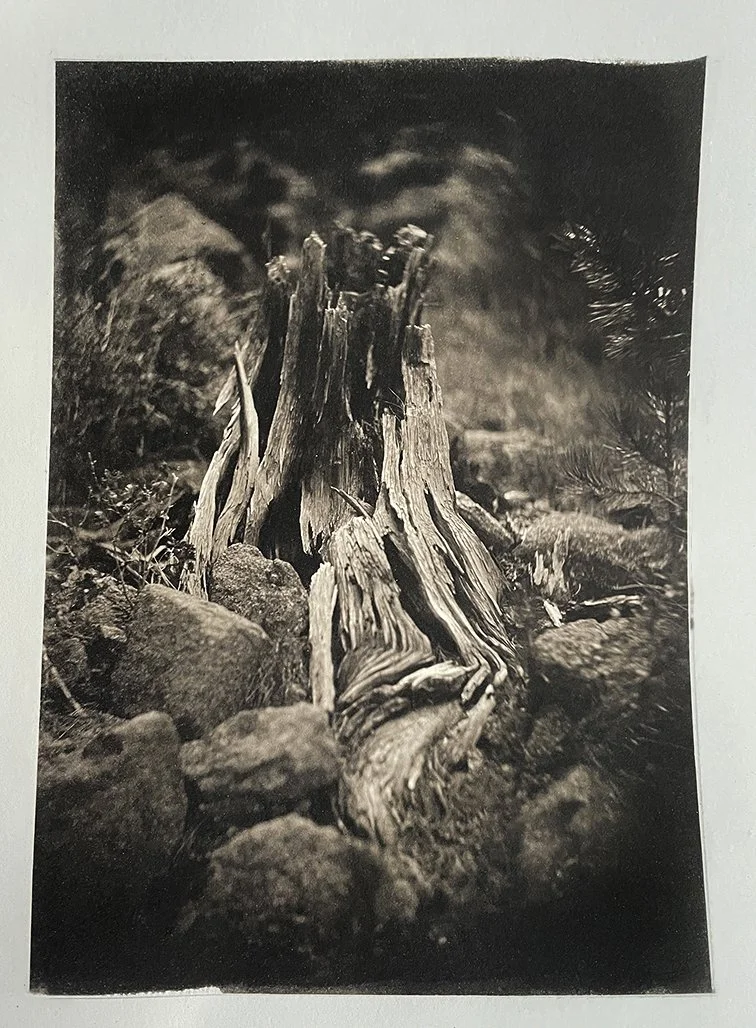It seems that most people working in these processes are firmly rooted in commercial work or are immersed in constant technical talk about processes and equipment (I’ve written several essays on this topic). There seems to be so little real output of expression or ideas using these processes. To be honest, it bores me to death; I have nothing left to say about it. So whatever I do next, I'll be prepared for it. If it involves photography, it won’t be commercially based or solely technical—it will be personal and expressive. It'll come to me naturally and organically, just like this work and my previous work have.
PLANS FOR THIS YEAR
For 2023, I’m going to continue to work on the “flora” portion of my project. I have several more plants I want to photograph as well as try some new approaches to making these images. There are quite a few landscape images I’m after, and I'll attempt some “fauna” work as well. I’ll continue to work it out and discover new ways to communicate these ideas semiotically.
I’m still very much in "creation mode" for the project—work, work, work—meaning that I’ll spend a few months editing a lot of photographs (about 200 images) and deciding what best represents my ideas for the concepts. I’m sitting on about 130 negatives from the work I did last year (2022). These are wet and dry collodion negatives, as well as paper negatives (calotypes). I have about 30 to 40 photogenic drawing prints and cyanotypes, too. I’ll have several print-out-processes to select from as well. Different negatives print differently in various P.O.P. processes. Even the paper selection can make a big difference. It's a lot of work, but it's also a lot of fun.
This year, I plan to do another 100–125 negatives plus several photogenic drawings and cyanotypes. I want a large variety to work with. The book will have between 75 and 100 images. To get that, I’ll need about 200 images to edit from. They will vary in process, too. There will be palladiotypes, kallitypes, salt prints, gelatin and collodion aristotypes, cyanotypes, Rawlins oil prints, and photogenic drawing prints. The substrate and execution will vary too. I’m going to try to make some very interesting images involving both content and process. They will be unique and, hopefully, engaging and interesting. That’s the goal. I want the visuals to connect with and represent the writing (concept) of the work more than anything else.
I’m thinking that this year’s work won’t be shared online. As much as I like sharing the work, I think I may keep this second year to myself. When I publish the book, I want most of the images to be "new" to the viewers. I think that seeing the photographs in the book with all of the text available adds more power to the concept. I hope those interested will stay tuned for the book. It will be worth the wait, I promise.
MY THOUGHTS ON SHARING, & SOCIAL MEDIA
I enjoy sharing work with people online. Most of the time, it’s a very positive experience. It builds community and is generally a positive thing. I try to stay away from the contentious stuff and just share with those that are interested. That will change somewhat over the coming year and the rest of this work. I’ll explain why.
I’ll continue to publish essays here (on my blog) over the coming year. This is like a public journal for me. I “exercise” stuff from my mind here; it’s cathartic for me. Sometimes, I’ll even come back to it to find something I’ve written about or a reference. It’s a good thing for me. And to those that read it, thank you, and thanks for the positive and kind words about it. So what about social media?
Social media has a tight grip on all of us—too much control over our personal, artistic, and creative lives. Too much influence is placed on what people will "like" or not, and the number of “likes.” Why do we put so much weight on social media? We want those dopamine hits! I get it.
Beyond that, there's surveillance capitalism and the data these large corporations are gathering on us via these platforms—it's intrusive and scary! We give it to them freely and ignorantly. Every Facebag survey you take on "What Kind of Potato Are You?" (or some other ridiculous thing) is simply getting more information about you to sell you stuff that you don’t need. These platforms are constantly encouraging people to compare themselves to each other (especially dangerous for young people). And the algorithms determine what will keep you scrolling for hours on end—so-called doom scrolling—and then feed it to you on an endless loop.
There’s so much negativity on these platforms. That alone should keep us away, but it doesn’t. The arguing and fighting over who is the best and smartest, as well as the "experts" shouting down, belittling, and degrading others, and the cultural and political squabbles, are heartbreaking. It's exactly what I read about and write about every day—existential uncertainty—and this is how people deal with the anxiety.
I see a lot of (malignant) narcissism on these platforms as well: “filtered selfies” and great lifestyles that are all fake. I get that people use it to bolster their self-esteem—life is difficult and frightening, and the knowledge of our impending death (death anxiety) drives us to deny it and act out this way—and social media assists in doing exactly that. In his book The Denial of Death, Ernest Becker said, "But it is too all-absorbing and relentless to be an aberration; it expresses the heart of the creature: the desire to stand out, to be the one in creation. When you combine natural narcissism with the basic need for self-esteem, you create a creature who has to feel himself an object of primary value: first in the universe, representing in himself all of life."
Every day, people post something that says, in essence, "Please like me and validate my existence; I seek meaning and significance." This is what Becker talks about constantly in his books. I wish there was a viable alternative. When I first started the Collodion Forum Board in 2003, there was a great community there. It lasted for a few years. People were courteous, kind, and generous with their knowledge and information. It didn’t have all of the negative aspects that we see on social media today (photo groups and egos). A lot of people working in wet collodion today got their start there - in fact most of them. Times change, and we move on. I wax nostalgic.
I think I can convince people that there are better and healthier ways to bolster their self-esteem. My book has nothing to do with "self-help,” but it will talk about ways to deal with death anxiety without being so self-centered and destructive.
There are some positive things about social media (very few things), but as a whole, the liabilities outweigh any of the good or positive things. I want to break the rules and try something different, like not sharing everything I make. How novel is that?
MOUNTAIN LIVING & SOLITUDE
I’ve had a few months of writing and time to lay out the book for its first iteration. So far, I feel great about what I’ve written. The writing has really allowed me to think about the photographs I want to make. This time has been priceless in that way. I write every day, seven days a week, some days more than others, but I still write. And I read every day, too. I’m always looking for books, films, music, and art in general that may have some connection to these ideas. I take in a wide variety of information; it seems to help me make the connections I need to write about these theories. I’ve written a lot about being fully aware of how I’m using art and creativity to buffer my own anxiety. I would go even farther and say that I’m not only buffering the anxiety, I’m feeding off of it. In other words, I’m using existential terror creatively in my favor. I feel like I'm getting one over on my own death awareness.

















